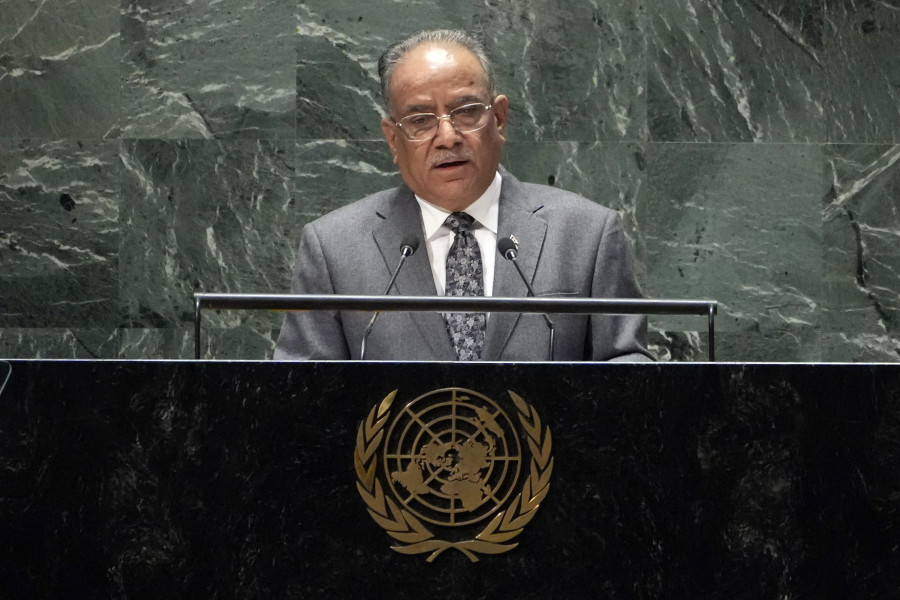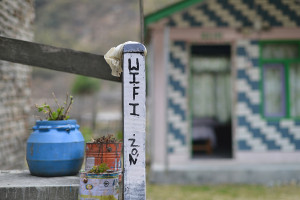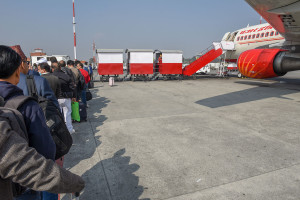Columns
Good governance for SDGs
Developed countries must rise to meet their long-term commitments for overseas development assistance.
Bishal Thapa
Speaking at the United Nations Sustainable Development Goal (SDG) Summit 2023 in New York earlier this week, Prime Minister Pushpa Kamal Dahal “Prachanda” delivered some grim news about the status on the attainment of the goals.
The UN adopted the SDGs, often referred to as the Global Goals, in 2015 as a universal call to action to end poverty, protect the planet, and ensure that by 2030 all people enjoy peace and prosperity. The SDGs are integrated into 17 specific goals spread across social, economic and environmental sustainability. All countries have committed to achieving the SDGs and prioritising progress for those who are the furthest behind.
In his address to the UN, the prime minister spoke first on behalf of the least developed countries (LDC). Nepal currently serves as the chair of the Global Coordination Bureau of countries in the LDC group. “Halfway to the 2030 deadline, we are seriously off-track in achieving the SDGs,” the prime minister said.
The prime minister was pointing to the UN report released earlier this year on the status of the SDGs which showed that progress in 50 percent of the SDGs was weak and insufficient. Progress in another 30 percent had stalled or gone into reverse. Without immediate action, the report concluded, “the 2030 Agenda [on SDGs] could become an epitaph for a world that might have been.”
Twelve of the 17 SDGs refer explicitly to LDCs. As the prime minister pointed out in his remarks to the UN General Assembly, more than half of the world is being left behind, most from the least developing countries.
As the chair of the coordinating bureau of the LDC group, the prime minister called for “massive scaling up of affordable finance to LDCs including through the SDG stimulus package.” He also called for appropriate debt solutions, in view of the growing debt distress of the LDCs, and urged “developed countries to scale up and fulfil their commitments to providing 0.7 percent of the Gross National Product (GNP) as overseas development assistance.”
The prime minister identified finance as the critical fuel driving SDG progress. “And the achievement of SDGs in LDCs defines its success or failure,” he said.
SDG progress in Nepal
Nepal has a progressive framework that integrates the SDGs within its national commitments under the principle of “leaving no one behind”. It has conducted two reviews of its SDG performance thus far, the last one in June 2020.
Nepal demonstrates mixed progress in achievement towards the SDGs. On most counts of poverty reduction, for example, Nepal was ahead of the target as of 2019, with approximately 1.1 percent reduction in poverty annually. Progress in health, on the other hand, has been modest with little gains in the targets of maternal and child mortality.
SDG 7, which aims to ensure access to affordable, reliable, sustainable and modern energy for all, is an illustration of a section where measurements of progress also need additional subjective interpretation. The subjective interpretation, and additional context, helps better understand the challenge of truly living up to Nepal’s principle of “leaving no one behind”.
The headline measurement of the proportion of population with access to electricity has increased significantly in Nepal. Electricity had reached approximately 90 percent of the population by 2019, which is well ahead of its target for that year. At this rate, Nepal seems on track to achieve its goal of 99 percent with access to electricity by 2030. Electricity access is already at around 97 percent.
The increases in electricity access have been made possible, in part, by increased electricity supply. Nepal reports that by 2018, the demand and supply of electricity were already in balance at 1,320 and 1,408 megawatts in 2018 and 2019 respectively. The increase in electricity supply has also meant that Nepal’s per capita electricity consumption had increased to 230 kWh by 2019, surpassing its goal of 230 kWh for that year. Its target is to increase per capita electricity to 1,500 kWh by 2030, an almost six-fold increase from 2019 levels.
The gains in per capita electricity consumption, however, masks significant inequality in electricity consumption. Fifty percent of all households with electricity access consume less than 20 kWh per month. This would place per capita electricity for 50 percent of the households at less than 50 kWh, which is one-fifth of the average per capita electricity reported in the progress report.
With such high disparities in electricity consumption within the population, it is hard to imagine that the poorest sections are not being left behind. More importantly, Nepal’s energy policies are not geared to ensuring that the development needs of weaker sections that are at the greatest risk of being left behind are fully addressed.
One illustration of how vulnerable groups are further at risk of being left behind can be seen through Target 7.2 of the SDG: Renewable energy share in the total final energy consumption. For many rural communities, distributed renewable energy offered the means for reliable electricity access, which in turn enabled them to increase consumption. As the grid expanded to bring the wire to their homes, it eroded the role of renewable energy which had helped to plug the reliability gap of the grid.
Nepal’s share of renewable energy in the total final energy consumption remains woefully short of target, at 5 percent in 2019 against a target of 22 percent. By 2030, Nepal has set a target for 50 percent, a ten-fold increase over current levels. This target isn’t even plausible, suggesting that the poor in Nepal will continue to be left out though they may never be counted in the statistics.
Accelerating SDG progress
Globally, overall progress on the SDGs is so significantly off track that it led the prime minister to say that the “SDGs are in dire need of a rescue plan”, a statement he borrowed from the UN’s own assessment.
Within the introspection over why the SDGs are off track, there wasn’t enough emphasis on accountability and good governance of national governments. Corruption, political impunity and increased authoritarianism in national governments are equally undermining progress in SDGs, perhaps as much as the lack of financial support from developed countries.
As the SDG Summit began, world leaders adopted a sweeping political declaration reaffirming commitment to achieving the SDGs. In the 12 pages over which the declaration was spread, the word “governance” appears only three times.
“Sustainable development cannot be realised… effective rule of law and good governance at all levels and on transparent, effective, and accountable institutions. Factors which give rise to violence, insecurity, and injustice, such as inequality, corruption, poor governance and illicit financial and arms flows, are addressed in the Agenda.”
The calls that the prime minister made at the UN SDG Summit for scaling up affordable finance to the LDCs, and in ways that help to address their growing debt distress while providing space for investments in infrastructure, are no doubt critical to the rescue plan for SDGs. Developed countries must rise to meet their long-term commitments for overseas development assistance.
At the same time, national governments must also do their share. Be less corrupt, more accountable, and transparent.




 11.12°C Kathmandu
11.12°C Kathmandu















